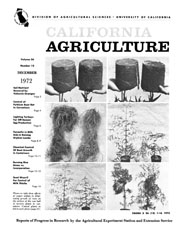


University of California
California Agriculture
|
|||
|
|||

Cover:
Photos to right show effects of copper sulfate in eliminating growth of roots on the surface of the root ball of nursery plants in containers. Control plants to left in each photo.
December 1972
Volume 26, Number 12 News and opinion |
|||
|
University of California, 1301 S. 46th St., Bldg. 478 Richmond, CA
|